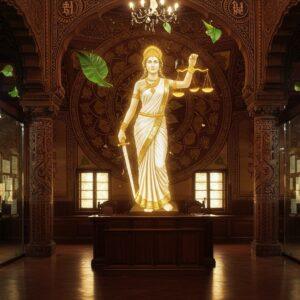
In the vibrant tapestry of Indian tradition, the Vedas shine as beacons of spiritual and scientific wisdom. The Upavedas, often referred to as ancillary or applied sciences, extend this profound knowledge into practical realms, enriching our daily lives with timeless insights. This exploration invites you to delve into these captivating applied sciences and discover their enduring relevance in our modern world.
Unveiling the Essence of Upavedas
Upavedas, meaning ‘secondary knowledge’ in Sanskrit, are essential texts that complement the four principal Vedas: Rigveda, Samaveda, Yajurveda, and Atharvaveda. These supplementary scriptures delve into applied sciences, offering practical wisdom firmly rooted in Vedic philosophy. Each Upaveda connects to a specific Veda, preserving time-honored practices while remaining remarkably relevant in today’s world. Understanding the Upavedas bridges the gap between ancient traditions and modern applications, deepening our appreciation for these enduring sciences.
Exploring the Four Upavedas
Let’s embark on a journey to discover the distinct Upavedas:
- Ayurveda (The Science of Life): Connected to the Rigveda, Ayurveda is India’s ancient and revered health system, emphasizing balance and holistic well-being. It provides a framework for physical, mental, and spiritual harmony.
- Dhanurveda (The Martial Arts): Originating from the Yajurveda, Dhanurveda encompasses martial arts and weaponry skills, historically vital for warriors. It delves into the art of self-defense and the principles of righteous combat.
- Gandharvaveda (The Art of Music): Tied to the Samaveda, Gandharvaveda explores the enchanting world of music and performing arts. It enriches cultural expressions and provides a pathway to spiritual elevation through artistic pursuits.
- Sthapatyaveda (The Art of Architecture): Linked to the Atharvaveda, Sthapatyaveda focuses on architecture and sculpture. It guides the creation of aesthetically pleasing and spiritually resonant structures, shaping our physical environment with wisdom and intention.
Each Upaveda offers unique insights into the practical application of Vedic knowledge in diverse aspects of life, enriching our understanding of the interconnectedness of all things.
Ayurveda: Discovering Holistic Health
Ayurveda, the world’s oldest known system of natural medicine, prioritizes harmony among body, mind, and spirit. This holistic health system utilizes herbs, diet, and lifestyle practices to maintain equilibrium. Key concepts include the three doshas—Vata, Pitta, and Kapha—which are fundamental to understanding individual health. Ayurveda’s principles remain remarkably relevant today, experiencing a resurgence in modern wellness practices for their focus on natural healing and balance. Explore our range of Ayurvedic products here and here.
Dhanurveda: Exploring the Ancient Art of Warfare
Dhanurveda encompasses the knowledge of weaponry and martial arts from ancient India. It played a crucial role in training warriors, equipping them with essential skills like archery and swordsmanship. These traditional practices have profoundly influenced contemporary martial arts and self-defense techniques, demonstrating the lasting cultural significance of Dhanurveda. You can find related items on Poojn.in here.
Gandharvaveda: Harmonizing Soul with Sound
Gandharvaveda delves into the captivating realm of music and dance. Closely linked with the musical hymns of the Samaveda, it forms the foundation of classical Indian music. This Upaveda teaches about ragas and talas—the melodic modes and rhythmic cycles that bring spiritual upliftment and emotional depth to musical expression. In Gandharvaveda, music transcends mere entertainment; it becomes a pathway to connect with the divine. Its principles continue to shape India’s rich cultural expressions through enchanting melodies and captivating performances. Discover traditional instruments and ritual items that resonate with Gandharvaveda here.
Sthapatyaveda: Crafting Timeless Creations
Sthapatyaveda, associated with the Atharvaveda, encapsulates the essence of architectural brilliance. This Upaveda guides the creation of awe-inspiring temples, magnificent palaces, and harmonious cities using traditional techniques and sustainable materials. The principles of Sthapatyaveda ensure that structures are not only aesthetically pleasing but also spiritually resonant, creating spaces that uplift and inspire. These time-honored practices continue to inspire modern architects to blend tradition with innovation in their designs. Enhance your understanding of Sthapatyaveda with resources available here.
The Vedangas: Supporting the Vedic Sciences
The Vedangas complement these applied sciences by providing essential tools for understanding and interpreting Vedic texts. They are like the scaffolding that supports the magnificent structure of Vedic knowledge. For instance, Shiksha (Phonetics) guides the proper pronunciation of sacred sounds; Kalpa (Rituals) outlines the precise procedures for ceremonies; Vyakarana (Grammar) ensures linguistic accuracy and clarity; Nirukta (Etymology) unlocks the deeper meanings of words; Chandas (Metrics) focuses on the poetic meter and rhythm of Vedic hymns; and Jyotisha (Astronomy/Astrology) connects celestial events with earthly occurrences.
Poojn.in: Your Companion on the Vedic Path
Poojn.in offers invaluable support for those seeking to integrate the Upavedas and Vedangas into their lives. Our thoughtfully curated collection of authentic ritual items is designed to enhance your practice and deepen your connection to these ancient sciences. Explore our offerings for Ayurveda, Dhanurveda, Gandharvaveda, and Sthapatyaveda on our website. We are committed to providing genuine, high-quality products that honor the sanctity of Vedic traditions. For personalized guidance, our knowledgeable team is available via phone at 03369029784 or WhatsApp at 9476142738. We offer pan-India delivery and secure payment options for your convenience.
Embracing the Wisdom of Upavedas
The Upavedas are far more than ancient texts; they are living bridges connecting timeless wisdom to the realities of our daily lives. Each Upaveda offers a unique lens through which to view the world, revealing how Vedic teachings remain remarkably relevant and vibrantly alive today. By exploring these applied sciences, we embrace a holistic perspective on health, strength, artistry, and architecture, fostering a deeper understanding of ourselves and the universe around us.
These applied sciences remind us of the inherent harmony between tradition and modernity, guiding us towards a life of balance, purpose, and creativity. As we integrate the teachings of the Upavedas into our lives, we honor the legacy of our ancestors and contribute to a future enriched by their profound knowledge. Let the Upavedas inspire you to explore new paths of understanding, deepen your appreciation for Indian heritage, and discover meaningful connections in your everyday experiences. This journey into the heart of Vedic applied sciences is an invitation to celebrate the richness of our culture and the enduring power of ancient wisdom. Explore more insightful articles on Vedic traditions and rituals here and here.
Frequently Asked Questions about Upavedas
What is an Upaveda? An Upaveda is a body of knowledge that applies the principles of the Vedas to specific fields, like medicine, martial arts, music, and architecture. They offer practical guidance based on Vedic wisdom.
What does Upaveda mean? The word “Upaveda” translates to “applied knowledge” or “secondary Veda.” It refers to the practical application of the spiritual and philosophical concepts found in the Vedas.
What are the different types of Upavedas? The four main Upavedas are Ayurveda (medicine), Dhanurveda (martial arts), Gandharvaveda (music and arts), and Sthapatyaveda (architecture). Each Upaveda explores a different realm of human endeavor.
Why are Upavedas important? The Upavedas offer practical wisdom for daily living, bridging the gap between spiritual principles and real-world applications. They provide valuable insights for enhancing personal well-being and contributing to a harmonious society. More on related topics are available here and here.


